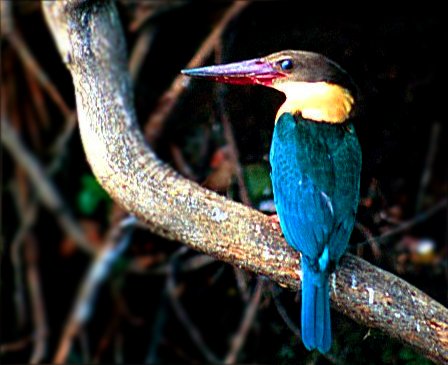- Stork-billed Kingfisher
Taxobox
name = Stork-billed Kingfisher

image_width = 200px
image_caption = Stork-billed Kingfisher from South India
status = LC | status_system = IUCN3.1
regnum =Animal ia
phylum = Chordata
classis = Aves
ordo =Coraciiformes
familia =Halcyonidae
genus = "Pelargopsis "
species = "P. capensis"
binomial = "Pelargopsis capensis"
binomial_authority = (Linnaeus, 1766)
synonyms = "Halcyon capensis"The Stork-billed Kingfisher, "Pelargopsis capensis" (formerly "Halcyon capensis"), is a
tree kingfisher which is widely but sparsely distributed in tropical southAsia fromIndia andSri Lanka toIndonesia . Thiskingfisher is essentially resident throughout its range.This is a very large kingfisher, 35 cm in length. The adult has a green back, blue wings and tail, and grey head. Its underparts and neck are buff. The very large bill and legs are bright red. The flight of the Stork-billed Kingfisher is laboured and flapping, but direct. Sexes are similar. There are 15 races, mostly differing in plumage detail, but "P. c. gigantea" of the Sulu Islands has a white head, neck and underparts. The call of this noisy kingfisher is a low and far reaching "peer-por-por" repeated every 5 seconds or so as well cackling "ke-ke-ke-ke-ke-ke".
Stork-billed Kingfisher is a species of a variety of well-wooded habitats near lakes, rivers or coasts. It perches quietly whilst seeking food, and is often inconspicuous despite its size. It is territorial and will chase away
eagle s and other large predators. This species hunts fish, frogs, crabs, rodents and young birds.Stork-billed Kingfisher digs its nest in a river bank, decaying tree, or a tree termite nest. A clutch of two to five round white eggs is typical.
References
* Database entry includes justification for why this species is of least concern
*Gallery
Wikimedia Foundation. 2010.
